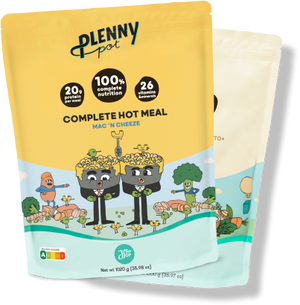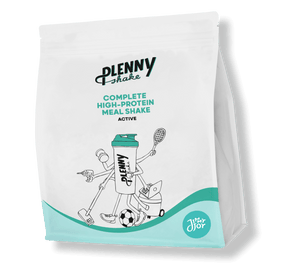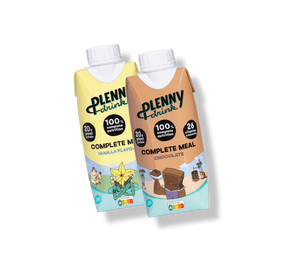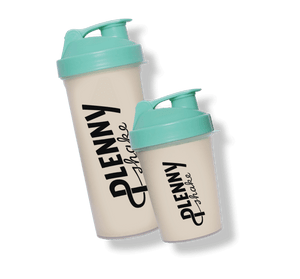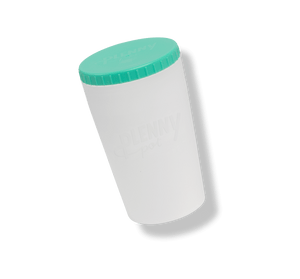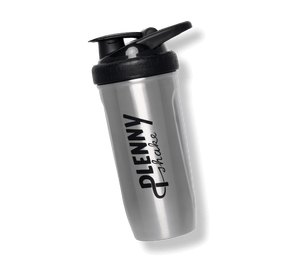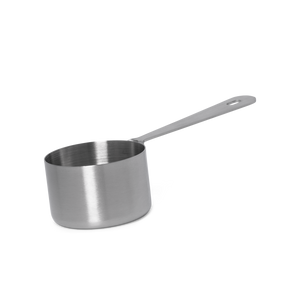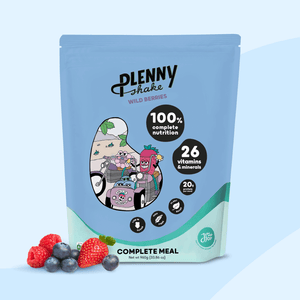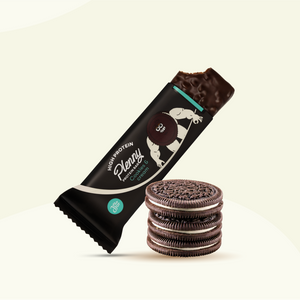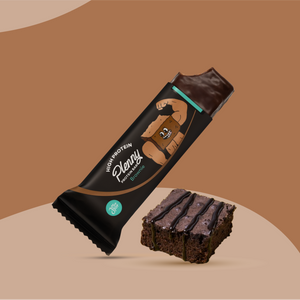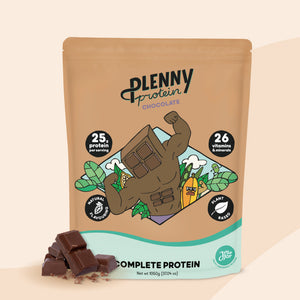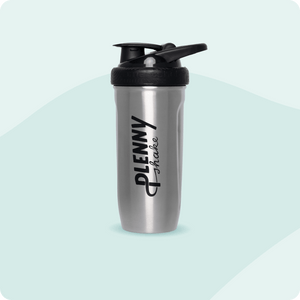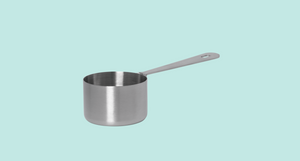Updated on June 11th, 2024
A meal that gives you everything you need - complete foods are becoming more and more popular! But with innovations come questions: are complete meals really that great?
This big question derives from smaller questions, and we’re going to answer them once and for all.
So just sit back, relax, and enjoy some knowledge while you sip your Plenny Shake or Plenny Drink. Ah, that leads us to the first question!
1. You need to chew your food… Right?
Chewing is a pretty essential part of eating: if you don’t chew before you swallow, you’ll choke. But you also have to chew properly - chunks of food are hard on your digestion. The food will stay in your stomach longer, which can lead to bloating, gas, constipation, and loss of energy [1].
But what if you don’t need to chew the nutrients... What if you can drink them?
Because our Plenny Shake and Plenny Drink are liquid meals, it raises the question of whether you should still chew or not. Let’s first take a look at what chewing does for your body.

Digestion is divided into two processes: mechanical digestion and chemical digestion. Chewing is part of mechanical digestion and involves grinding bigger chunks of food into smaller, more manageable pieces. This not only makes swallowing easier but also boosts saliva production which has amylases, and triggers the production of hydrochloric acid in the stomach, activating further steps in the digestive process. [2]
After you swallow your food (or should we say drink?) it goes down your oesophagus into your stomach, where the chemical digestion takes over. In the stomach and continuing in the small intestine, enzymes break down all the nutrients in your food, such as proteins, carbs, and fats, into parts that are small enough to be absorbed by your body. Without chemical digestion you could chew until your jaws were sore, but your body wouldn’t be able to absorb the nutrients, leading to malnutrition or vitamin deficiencies [3].
Liquid Meals
So, chewing releases saliva with enzymes to help with the process of digestion, but since some of our meals are liquid and not solid, chewing is not actually necessary.
Luckily, our nutritionally complete shakes and drinks can be efficiently digested and absorbed by the body, as the stomach contains all necessary enzymes for nutrient breakdown. You can profit from the 175 proven health benefits!
Just take a look at Lee’s 6-month Plenny Shake diet and the results of his blood tests.
Or check out this guy who’s lived on Plenny Shake for 3 years and counting. So far so good!
And if you don’t want to give up on chewing, no worries. We still have the Plenny Bars and Plenny Pots.
2. Synthetic vitamins and minerals aren’t absorbed by the body!
The second concern we often come across is about synthetic vitamins and how useful they actually are. Synthetic vitamins are isolated nutrients that are made artificially, whereas whole food supplements, such as our freeze-dried fruit, do not fall into this category. Now that we have gotten that out of the way, let's discuss vitamin pills.
Synthetic vitamins are usually found as pills. You take one of those a day to supplement your daily diet. Synthetic nutrients can offer benefits to all kinds of different people. For example the elderly, who are at higher risk of a vitamin D deficiency [5, 6] and vegans and vegetarians, who frequently lack vitamin B12 [7, 8]. Additionally, synthetic vitamins can help people who - for whatever reason - might suffer from nutrient deficiencies.

Too Much of a Good Thing
The notion that synthetic vitamins aren’t absorbed by your body simply is not true. They are absorbed by the body perfectly well! They should be used with caution though: certain vitamins can be harmful when taken in excess, such as vitamin A [9]. If you want to do it right, make sure you do regular blood tests to determine your body’s vitamin and mineral make-up before supplementing.
Working Together
Vitamins from whole foods are often recommended over synthetic vitamins because whole foods contain a mix of many different vitamins and minerals unlike single-vitamin pills. The mixture of nutrients work well together, allowing your body to absorb and use them in the most optimal way possible [10]. For example: vitamin C enhances iron absorption [11].
All-in-one
If you’re looking for a handy meal with a balanced mix of nutrients, including vitamins, minerals, proteins and fibres, and ensure they’re absorbed and used well by your body, you might wanna knock on our door. Jimmy Joy offers just exactly that. The ingredients we use, such as oats and flaxseed, contain naturally occurring vitamins and minerals, and the rest of the vitamins and minerals are fortified by our highly bioavailable vitamin and mineral mix.
In case you’re curious about the exact bioavailability of the vitamins and minerals in our products, we wrote up this article for you.
3. Carbs are bad for you!
Bread, potatoes, biscuits, pasta… Mmm, so yummy! But some believe carbs are evil and avoid carbs more than they avoid eye contact while eating a banana. So: how bad are carbs, really?

First, let’s establish what carbs are. Carbohydrates are macronutrients, and alongside fat and protein, they form a large part of our diets [12]. There are three types of carbs: sugar, starch, and fibres.
Sugar
Overconsuming sugar can lead to health problems such as diabetes, obesity, and heart disease [13]. It can also cause tooth decay [14]. Sugar is what we call a simple carb [15]: quickly digested and turned into a short burst of energy [15].
Starch
Starch is often found in foods that come from plants, like veggies, legumes, and grains. Most starches are broken down in the body by digestive enzymes, [16] which turns them into glucose. Your blood carries the glucose to your cells, to use for energy. Starch is a complex carb, meaning it releases energy gradually and steadily.
Fibre
Fibre is also a complex carbohydrate, but the difference between fibre and starch is that fibre can’t be broken down by your digestive enzymes [15]. Fibres are great because they keep your digestive system healthy and help prevent constipation [17]. They can be found in cereals, fruits, vegetables [18], and - of course - Plenny meals which contain from 5.9 to 8.3g of fibre per portion depending on the meal.

Simple & complex Carbs
The difference between simple and complex carbs is that complex carbs take longer to digest and offer more energy throughout a longer period [16]. Say you eat a cube of sugar and a similar sized cube of wholegrain bread - you’d benefit more from the latter. Simple carbs have shorter molecule chains than complex carbs [19]. Those molecule chains get broken down and are turned into glucose, which your body uses for energy. Shorter chains get broken down faster, so it’s no surprise sugar gets broken down and absorbed faster than starch.
Carbs are your body’s main source of energy [20]. Sure, consuming tons of sugar everyday isn’t the best idea, but starchy carbs and fibres definitely have their benefits!
Luckily, Plenny meals contain plenty of complex carbs and fibres: oats, flaxseed, soy, tapioca starch, rice, and inulin provide a minimum of 5.9 gram of fibre per meal.
So complete meals really are that great...?
Simply put: yes!
Chewing
Chewing is not exactly necessary when you’re having a drinkable meal, since you still make the enzymes to break down your food in your stomach and small intestine.
Synthetic Vitamins
Synthetic vitamins do get absorbed by the body, but unless you have a serious deficiency it is best to consume your vitamins & minerals with high bioavailability and in a balanced mix to ensure optimal absorption.
Carbs
Carbs are necessary to keep your energy levels up throughout the day. They’re great as long as your carb intake involves complex carbs and doesn’t consist of spoonfuls of sugar.
Complete foods
Complete foods are pretty great, especially if you don’t have a lot of time to prepare perfectly balanced meals. Instead of having to prepare your carbs, proteins and fibres separately while also fumbling about with supplements to get your daily dose of essential micronutrients, how about a Plenny Drink instead? Just twist off the cap, take a few sips, and you’ve consumed your needed nutrients for a meal. Convenient, healthy, and tasty!
Sources
- Kumar A, Almotairy N, Merzo JJ, Wendin K, Rothenberg E, Grigoriadis A, et al. Chewing and its influence on swallowing, gastrointestinal and nutrition-related factors: a systematic review. Critical Reviews in Food Science and Nutrition [Internet]. 2022 Jul 14;63(33):1–31. Available from: https://www.tandfonline.com/doi/full/10.1080/10408398.2022.2098245
- Wright JV, Lenard L. Why Stomach Acid Is Good for You : Natural Relief from heartburn, indigestion, reflux, and GERD. Lanham, MD: M. Evans; 2001.
- National Institute of Diabetes and Digestive and Kidney Diseases. Your Digestive System & How It Works [Internet]. National Institute of Diabetes and Digestive and Kidney Diseases. 2017. Available from: https://www.niddk.nih.gov/health-information/digestive-diseases/digestive-system-how-it-works#howdoes
- Ash M. Digestive Enzymes | Clinical Education [Internet]. Clinical Education. 2017. Available from: https://www.clinicaleducation.org/news/digestive-enzymes/
- Baik HW, Russell RM. Vitamin B12 Deficiency in the Elderly. Annual Review of Nutrition [Internet]. 1999 Jul;19(1):357–77. Available from: https://www.annualreviews.org/content/journals/10.1146/annurev.nutr.19.1.357
- Tang BM, Eslick GD, Nowson C, Smith C, Bensoussan A. Use of Calcium or Calcium in Combination with Vitamin D Supplementation to Prevent Fractures and Bone Loss in People Aged 50 Years and older: a meta-analysis. The Lancet [Internet]. 2007 Aug;370(9588):657–66. Available from: https://doi.org/10.1016/S0140-6736(07)61342-7
- Pawlak R, Parrott SJ, Raj S, Cullum-Dugan D, Lucus D. How Prevalent Is Vitamin B(12) Deficiency among vegetarians? Nutrition Reviews [Internet]. 2013;71(2):110–7. Available from: https://www.ncbi.nlm.nih.gov/pubmed/23356638
- Craig WJ. Nutrition Concerns and Health Effects of Vegetarian Diets. Nutrition in Clinical Practice [Internet]. 2010 Dec;25(6):613–20. Available from: https://doi.org/10.1177/0884533610385707
- Johnson LE. Vitamin a Excess - Disorders of Nutrition [Internet]. MSD Manual Consumer Version. 2022. Available from: https://www.msdmanuals.com/home/disorders-of-nutrition/vitamins/vitamin-a-excess
- Liu RH. Health Benefits of Fruit and Vegetables Are from Additive and Synergistic Combinations of Phytochemicals. The American Journal of Clinical Nutrition [Internet]. 2003 Sep 1;78(3):517S520S. Available from: https://academic.oup.com/ajcn/article/78/3/517S/4689990
- Hallberg L, Brune M, Rossander L. The Role of Vitamin C in Iron Absorption. International Journal for Vitamin and Nutrition Research Supplement = Internationale Zeitschrift Fur Vitamin- Und Ernahrungsforschung Supplement [Internet]. 1989;30:103–8. Available from: https://pubmed.ncbi.nlm.nih.gov/2507689/
- American Diabetes Association. Get to Know Carbs [Internet]. www.diabetes.org. Available from: https://www.diabetes.org/healthy-living/recipes-nutrition/understanding-carbs/get-to-know-carbs
- NHS Choices. Healthy Weight [Internet]. NHS. 2020. Available from: https://www.nhs.uk/live-well/healthy-weight/why-we-need-to-eat-carbs
- NHS . Sugar: the Facts [Internet]. NHS. 2019. Available from: https://www.nhs.uk/live-well/eat-well/how-does-sugar-in-our-diet-affect-our-health/
- American Heart Association. Carbohydrates [Internet]. www.heart.org. 2018. Available from: https://www.heart.org/en/healthy-living/healthy-eating/eat-smart/nutrition-basics/carbohydrates
- Slavin J, Carlson J. Carbohydrates. Advances in Nutrition [Internet]. 2014 Nov 1;5(6):760–1. Available from: https://www.ncbi.nlm.nih.gov/pmc/articles/PMC4224210/
- NHS Choices. How to Get More Fibre into Your Diet [Internet]. NHS. 2019. Available from: https://www.nhs.uk/live-well/eat-well/how-to-get-more-fibre-into-your-diet/
- Better Health. Fibre in Food [Internet]. Better Health Channel. 2021. Available from: https://www.betterhealth.vic.gov.au/health/healthyliving/fibre-in-food
- Holesh JE, Martin A, Aslam S. Physiology, Carbohydrates [Internet]. Nih.gov. StatPearls Publishing; 2023. Available from: https://www.ncbi.nlm.nih.gov/books/NBK459280/
- Jéquier E. Carbohydrates as a Source of Energy. The American Journal of Clinical Nutrition [Internet]. 1994 Mar 1;59(3):682S685S. Available from: https://pubmed.ncbi.nlm.nih.gov/8116550/
- Burton-Freeman B. Dietary Fiber and Energy Regulation. The Journal of Nutrition [Internet]. 2000 Feb 1;130(2):272S275S. Available from: https://academic.oup.com/jn/article/130/2/272S/4686350
- WebMD Editorial Contributors. Ketosis [Internet]. WebMD. 2022. Available from: https://www.webmd.com/diabetes/what-is-ketosis#1
- Bhupathiraju SN, Hu F. Overview of Nutrition - Nutritional Disorders [Internet]. MSD Manual Professional Edition. 2023. Available from: https://www.msdmanuals.com/professional/nutritional-disorders/nutrition-general-considerations/overview-of-nutrition?query=Carbohydrates

 Everything You Need In One Meal
Everything You Need In One Meal
 Stay Full For 3-5 Hours
Stay Full For 3-5 Hours







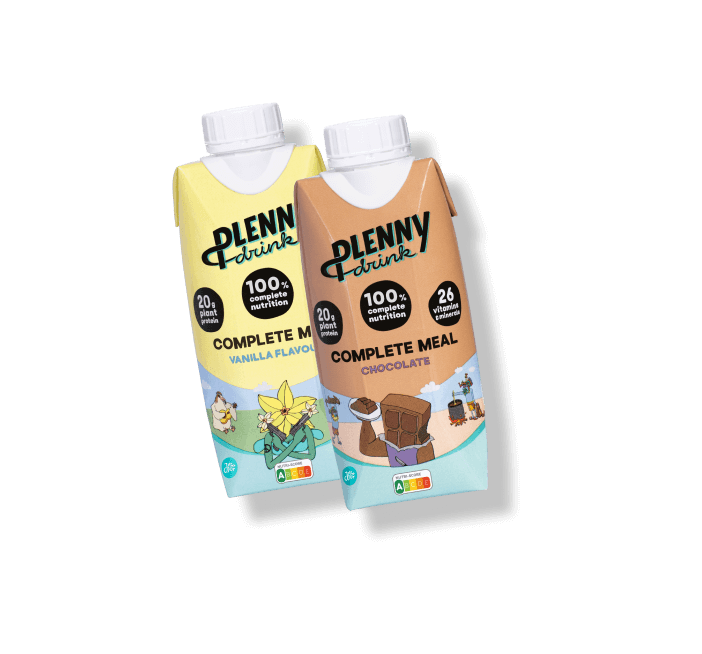
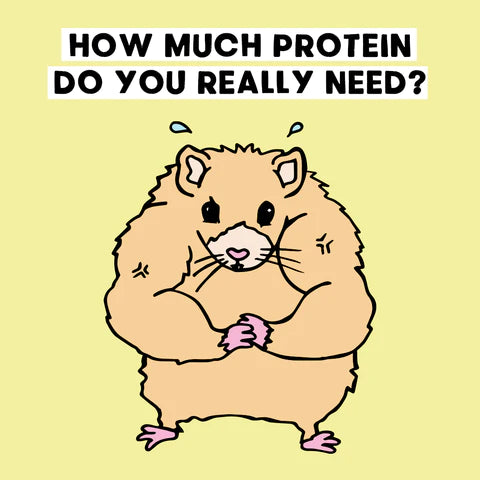











 Product added to cart
Product added to cart



